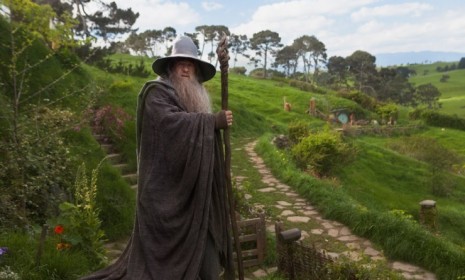8 troubling tales of animal abuse on film shoots
Peter Jackson's zealously anticipated The Hobbit is marred by accusations that 27 animals died due to unsafe conditions. Sadly, the Middle-Earth movie is not alone

There's trouble brewing in Middle-Earth, the fantasy setting of next month's geek-magnet blockbuster The Hobbit: An Unexpected Journey, with accusations flying that the film's crew permitted unsafe conditions for animals used during production. Indeed, animal rights activists are up in arms over reports that 27 animals died during The Hobbit's New Zealand shoot, reportedly because of dangerous conditions on the ranch where the animals were being kept. Sadly, The Hobbit is only the latest movie marred by reports of animal abuse. A brief history:
1. Ben-Hur (1925)
The chariot race in the silent classic Ben-Hur remains surprisingly thrilling today — but the intensity of the scene came at a significant price. At least 100 horses were killed during the filming of the scene.
The Week
Escape your echo chamber. Get the facts behind the news, plus analysis from multiple perspectives.

Sign up for The Week's Free Newsletters
From our morning news briefing to a weekly Good News Newsletter, get the best of The Week delivered directly to your inbox.
From our morning news briefing to a weekly Good News Newsletter, get the best of The Week delivered directly to your inbox.
2. The Charge of the Light Brigade (1936)
Without anti-animal abuse laws in place, filmmakers were free to do whatever they deemed necessary to get their action sequences. But 1936's The Charge of the Light Brigade took things too far with its extensive use of the "running W" — a type of trip wire used to make horses fall during the filming of its climatic scene. In response to the film's rampant abuses, the Society for the Prevention of Cruelty to Animals successfully petitioned to have the "running W" banned from further use.
3. Jesse James (1939)
Perhaps the key turning point against animal abuses on film came in the wake of Jesse James, a movie about the notorious outlaw. Two horses, outfitted with blinders, were tricked into running off a 75-foot cliff during production. The ruse was disguised, temporarily, by painting eyes on the horses' blinders. When word got out, the public outcry was so widespread that the Hays Office, which governed appropriate film content at the time, partnered with the American Humane Association to ban animal cruelty on film — eventually leading to the famous, reassuring phrase "No animals were harmed in the making of this film."
A free daily email with the biggest news stories of the day – and the best features from TheWeek.com
4. Pink Flamingos (1972)
For John Waters' independently produced, famously depraved cult film Pink Flamingos, which chronicles several characters' competition to earn the title "Filthiest Person Alive," the director included a scene in which two people aggressively use live chickens as sex toys. Asked later in his career about the on-set death of one chicken, Waters was unrepentant: "We bought the chicken from a farmer who advertised freshly-killed chicken. I think we made the chicken's life better: Got to be in a movie, got fucked… And then right after filming the next take, the cast ate the chicken."
5. Heaven's Gate (1980)
The ever-watchful eye of an on-set representative from the American Humane Association improved Hollywood's treatment of animals immeasurably, but filmmakers who elected to work without AHA oversight could still operate unchecked. Director Michael Cimino was one such filmmaker. He refused to allow the AHA on set of his western Heaven's Gate, leading to accusations of animal cruelty that included four dead horses, disemboweled cows, and unsimulated cockfights. The AHA picketed the film upon its release, and Heaven's Gate became one of the most notorious flops in cinema history.
6. Oldboy (2003)
The script for this Korean thriller called for the protagonist to eat a live octopus after enduring 15 years in captivity. Showing an almost unbelievable commitment to his role, star Choi Min-sik ate four live octopi when production required that the scene be shot four times. Min-sik, a dedicated Buddhist, reportedly said a prayer for each octopus, and apologized before shooting.
7. Manderlay (2005)
Director Lars von Trier is famous for his unrelentingly grim films, but his period drama Manderlay invited an especially angry response when an actual donkey was slaughtered on camera. Though a spokeswoman for the film protested that the donkey was due to be slaughtered anyway, and had actually lived two months longer after being acquired by the production, actor John C. Reilly was reported to have quit the film in protest. Von Trier eventually elected not to use the footage in the final film.
8. The Hobbit: An Unexpected Journey (2012)
The Hobbit is a more complicated case because its 27 alleged animal deaths occurred off-set, due to what animal wranglers on the film dubbed "death traps" (bluffs, sinkholes, and broken fences) on the New Zealand ranch where they were kept. Reportedly, chickens were mauled by dogs, a horse fell over a bluff, a pony broke his back, and goats and sheep contracted worms. PETA has vowed to protest the film's premiere. Amid the growing controversy, director Peter Jackson issued a statement insisting that animal safety concerns were "immediately investigated," with appropriate action taken.
Sources: E! Online (2), Salon (2), Canadian Broadcasting Corporation, Turner Classic Movies, The AV Club (2) (3), MSNBC, The Wrap
-
 ‘Maps are the ideal metaphor for our models of what the world might be’
‘Maps are the ideal metaphor for our models of what the world might be’Instant Opinion Opinion, comment and editorials of the day
-
 What is China doing in Latin America?
What is China doing in Latin America?Today’s Big Question Beijing offers itself as an alternative to U.S. dominance
-
 ‘One Battle After Another’ wins Critics Choice honors
‘One Battle After Another’ wins Critics Choice honorsSpeed Read Paul Thomas Anderson’s latest film, which stars Leonardo DiCaprio, won best picture at the 31st Critics Choice Awards